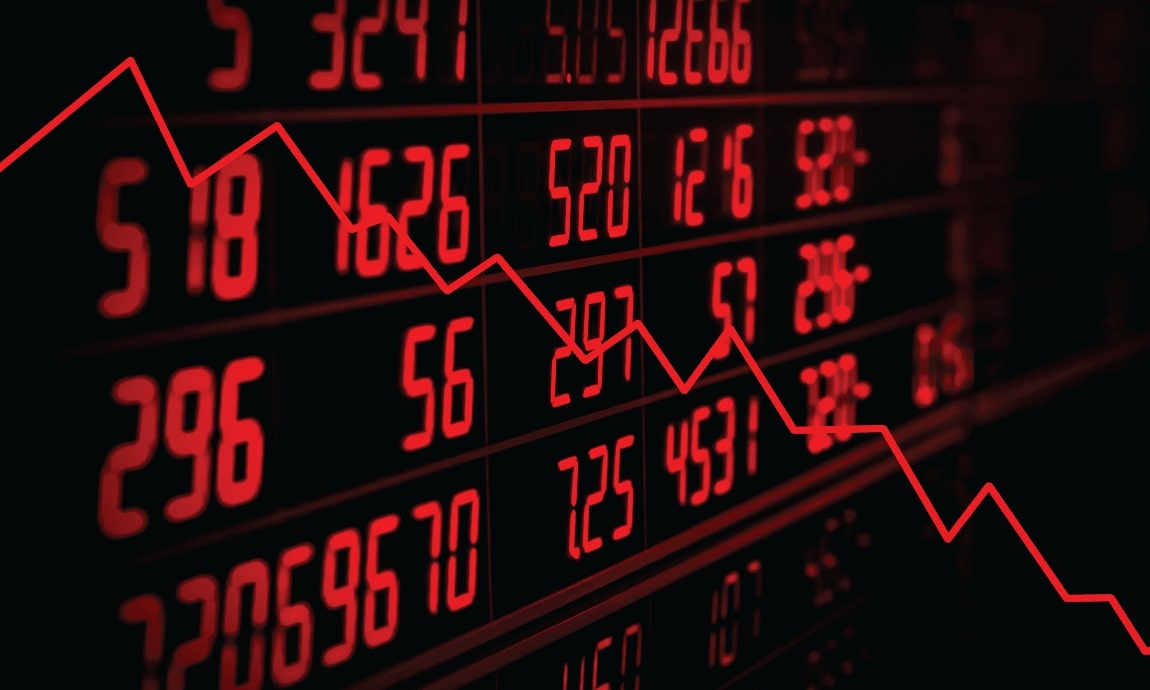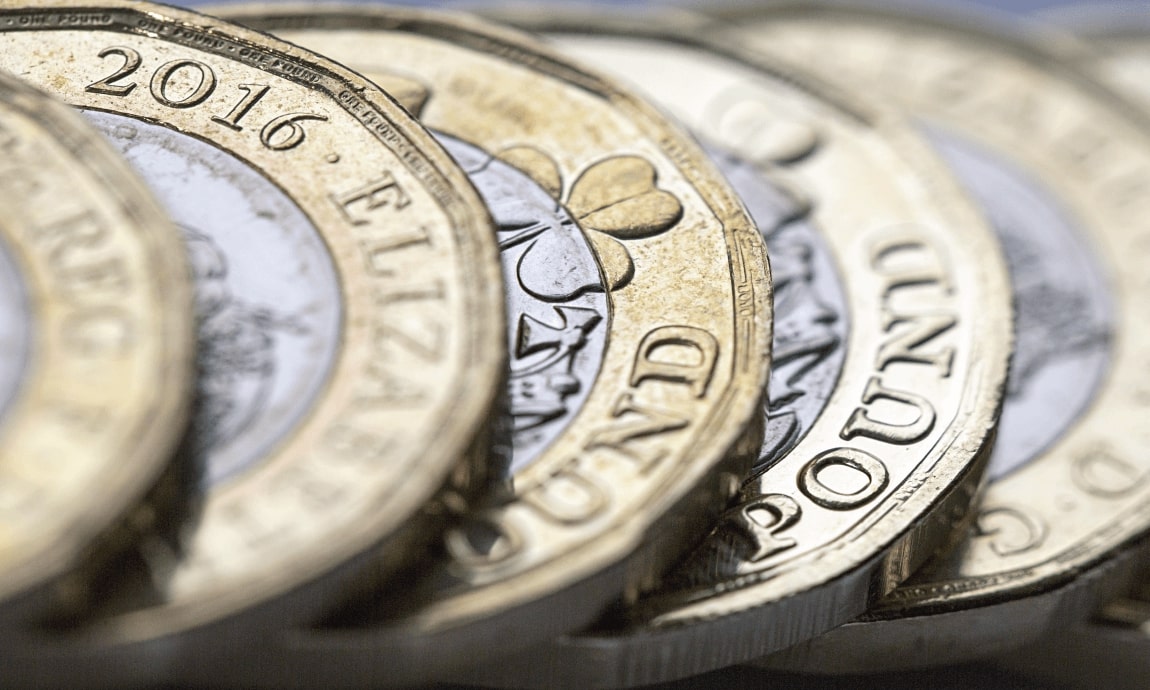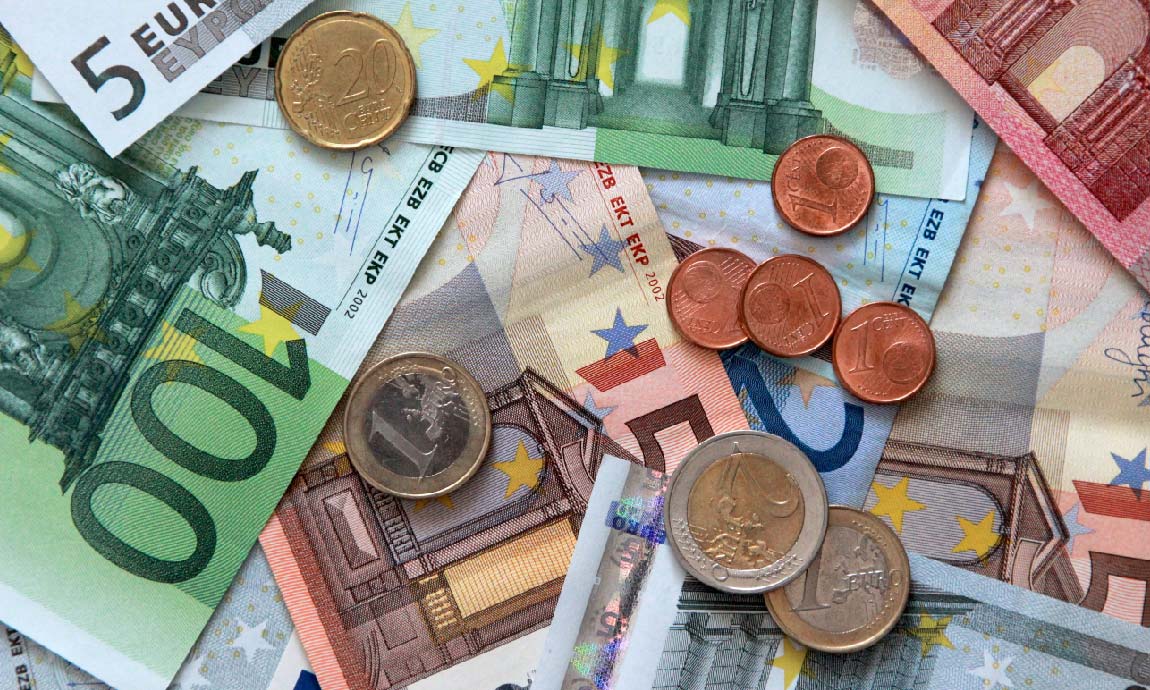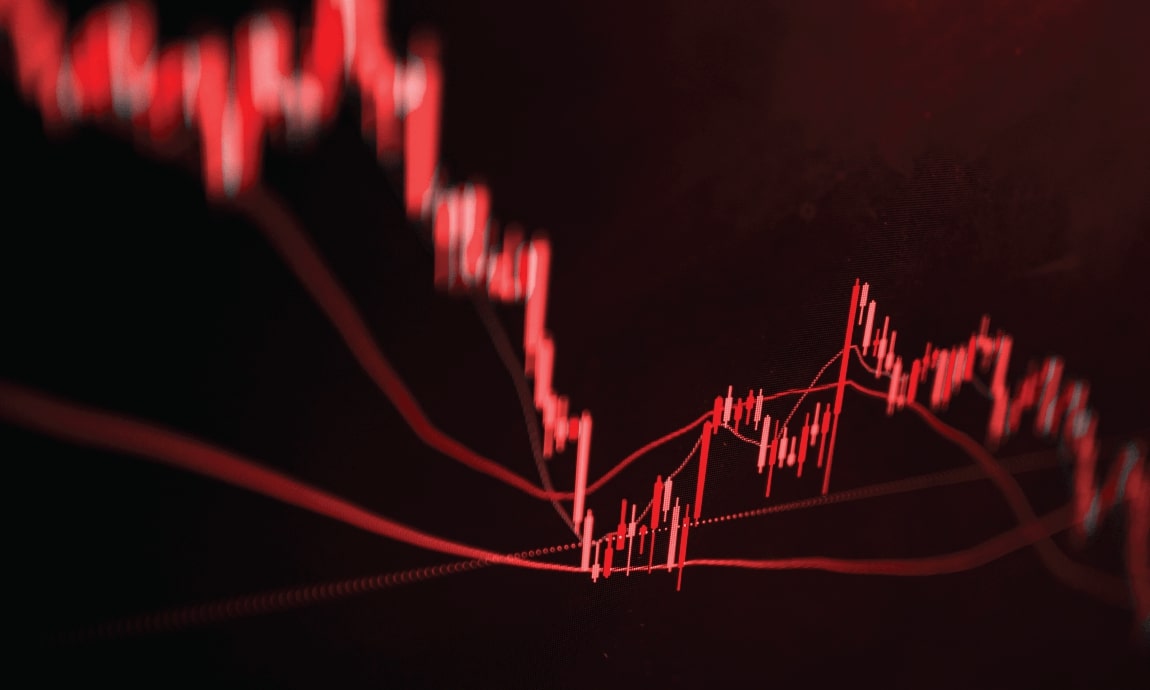As a result, both the S&P 500 and Nasdaq Composite settled lower by more than 0.40% on Wednesday and are on pace for their second consecutive losing week for the first time since December.
Yet, the 2-year note yield, which typically moves in step with interest rate expectations, reached levels not seen since 2007, climbing up to 4.937%.
As a result, both the S&P 500 and Nasdaq Composite settled lower by more than 0.40% on Wednesday and are on pace for their second consecutive losing week for the first time since December.
2-year U.S. Treasury yield, 3-month chart
Yet, the 2-year note yield, which typically moves in step with interest rate expectations, reached levels not seen since 2007, climbing up to 4.937%.
As a result, both the S&P 500 and Nasdaq Composite settled lower by more than 0.40% on Wednesday and are on pace for their second consecutive losing week for the first time since December.
2-year U.S. Treasury yield, 3-month chart
Yet, the 2-year note yield, which typically moves in step with interest rate expectations, reached levels not seen since 2007, climbing up to 4.937%.
As a result, both the S&P 500 and Nasdaq Composite settled lower by more than 0.40% on Wednesday and are on pace for their second consecutive losing week for the first time since December.
2-year U.S. Treasury yield, 3-month chart
Yet, the 2-year note yield, which typically moves in step with interest rate expectations, reached levels not seen since 2007, climbing up to 4.937%.
As a result, both the S&P 500 and Nasdaq Composite settled lower by more than 0.40% on Wednesday and are on pace for their second consecutive losing week for the first time since December.
In the U.S., the growing worries over higher interest rates for a longer period coupled with the lingering inflation have lifted the 10-year Treasury yields above 4% on Wednesday for the first time since early November 2022.
2-year U.S. Treasury yield, 3-month chart
Yet, the 2-year note yield, which typically moves in step with interest rate expectations, reached levels not seen since 2007, climbing up to 4.937%.
As a result, both the S&P 500 and Nasdaq Composite settled lower by more than 0.40% on Wednesday and are on pace for their second consecutive losing week for the first time since December.
In the U.S., the growing worries over higher interest rates for a longer period coupled with the lingering inflation have lifted the 10-year Treasury yields above 4% on Wednesday for the first time since early November 2022.
2-year U.S. Treasury yield, 3-month chart
Yet, the 2-year note yield, which typically moves in step with interest rate expectations, reached levels not seen since 2007, climbing up to 4.937%.
As a result, both the S&P 500 and Nasdaq Composite settled lower by more than 0.40% on Wednesday and are on pace for their second consecutive losing week for the first time since December.
The market is also concerned that borrowing costs are set to rise more than previously expected, weighing on future economic growth, as inflation has proved difficult to tame.
In the U.S., the growing worries over higher interest rates for a longer period coupled with the lingering inflation have lifted the 10-year Treasury yields above 4% on Wednesday for the first time since early November 2022.
2-year U.S. Treasury yield, 3-month chart
Yet, the 2-year note yield, which typically moves in step with interest rate expectations, reached levels not seen since 2007, climbing up to 4.937%.
As a result, both the S&P 500 and Nasdaq Composite settled lower by more than 0.40% on Wednesday and are on pace for their second consecutive losing week for the first time since December.
The market is also concerned that borrowing costs are set to rise more than previously expected, weighing on future economic growth, as inflation has proved difficult to tame.
In the U.S., the growing worries over higher interest rates for a longer period coupled with the lingering inflation have lifted the 10-year Treasury yields above 4% on Wednesday for the first time since early November 2022.
2-year U.S. Treasury yield, 3-month chart
Yet, the 2-year note yield, which typically moves in step with interest rate expectations, reached levels not seen since 2007, climbing up to 4.937%.
As a result, both the S&P 500 and Nasdaq Composite settled lower by more than 0.40% on Wednesday and are on pace for their second consecutive losing week for the first time since December.
Economists worry that those robust macroeconomic indicators could prompt both the Federal Reserve and European Central Bank to keep interest rates elevated for a longer time than anticipated to curb persistent inflation.
The market is also concerned that borrowing costs are set to rise more than previously expected, weighing on future economic growth, as inflation has proved difficult to tame.
In the U.S., the growing worries over higher interest rates for a longer period coupled with the lingering inflation have lifted the 10-year Treasury yields above 4% on Wednesday for the first time since early November 2022.
2-year U.S. Treasury yield, 3-month chart
Yet, the 2-year note yield, which typically moves in step with interest rate expectations, reached levels not seen since 2007, climbing up to 4.937%.
As a result, both the S&P 500 and Nasdaq Composite settled lower by more than 0.40% on Wednesday and are on pace for their second consecutive losing week for the first time since December.
Economists worry that those robust macroeconomic indicators could prompt both the Federal Reserve and European Central Bank to keep interest rates elevated for a longer time than anticipated to curb persistent inflation.
The market is also concerned that borrowing costs are set to rise more than previously expected, weighing on future economic growth, as inflation has proved difficult to tame.
In the U.S., the growing worries over higher interest rates for a longer period coupled with the lingering inflation have lifted the 10-year Treasury yields above 4% on Wednesday for the first time since early November 2022.
2-year U.S. Treasury yield, 3-month chart
Yet, the 2-year note yield, which typically moves in step with interest rate expectations, reached levels not seen since 2007, climbing up to 4.937%.
As a result, both the S&P 500 and Nasdaq Composite settled lower by more than 0.40% on Wednesday and are on pace for their second consecutive losing week for the first time since December.
On Wednesday, the Institute for Supply Management’s (ISM) survey showed U.S. manufacturing contracted in February by 47.7% vs 47.4% in January, while the manufacturing prices for raw materials increased last month by 51.3 vs 44.5 in January.
Economists worry that those robust macroeconomic indicators could prompt both the Federal Reserve and European Central Bank to keep interest rates elevated for a longer time than anticipated to curb persistent inflation.
The market is also concerned that borrowing costs are set to rise more than previously expected, weighing on future economic growth, as inflation has proved difficult to tame.
In the U.S., the growing worries over higher interest rates for a longer period coupled with the lingering inflation have lifted the 10-year Treasury yields above 4% on Wednesday for the first time since early November 2022.
2-year U.S. Treasury yield, 3-month chart
Yet, the 2-year note yield, which typically moves in step with interest rate expectations, reached levels not seen since 2007, climbing up to 4.937%.
As a result, both the S&P 500 and Nasdaq Composite settled lower by more than 0.40% on Wednesday and are on pace for their second consecutive losing week for the first time since December.
On Wednesday, the Institute for Supply Management’s (ISM) survey showed U.S. manufacturing contracted in February by 47.7% vs 47.4% in January, while the manufacturing prices for raw materials increased last month by 51.3 vs 44.5 in January.
Economists worry that those robust macroeconomic indicators could prompt both the Federal Reserve and European Central Bank to keep interest rates elevated for a longer time than anticipated to curb persistent inflation.
The market is also concerned that borrowing costs are set to rise more than previously expected, weighing on future economic growth, as inflation has proved difficult to tame.
In the U.S., the growing worries over higher interest rates for a longer period coupled with the lingering inflation have lifted the 10-year Treasury yields above 4% on Wednesday for the first time since early November 2022.
2-year U.S. Treasury yield, 3-month chart
Yet, the 2-year note yield, which typically moves in step with interest rate expectations, reached levels not seen since 2007, climbing up to 4.937%.
As a result, both the S&P 500 and Nasdaq Composite settled lower by more than 0.40% on Wednesday and are on pace for their second consecutive losing week for the first time since December.
The 20-member region has gone through substantial price increases in 2022 after Russia’s invasion of Ukraine pushed up energy and food costs across the bloc. However, the latest data provides further evidence that inflation has started to ease as energy prices have softened from previous levels.
On Wednesday, the Institute for Supply Management’s (ISM) survey showed U.S. manufacturing contracted in February by 47.7% vs 47.4% in January, while the manufacturing prices for raw materials increased last month by 51.3 vs 44.5 in January.
Economists worry that those robust macroeconomic indicators could prompt both the Federal Reserve and European Central Bank to keep interest rates elevated for a longer time than anticipated to curb persistent inflation.
The market is also concerned that borrowing costs are set to rise more than previously expected, weighing on future economic growth, as inflation has proved difficult to tame.
In the U.S., the growing worries over higher interest rates for a longer period coupled with the lingering inflation have lifted the 10-year Treasury yields above 4% on Wednesday for the first time since early November 2022.
2-year U.S. Treasury yield, 3-month chart
Yet, the 2-year note yield, which typically moves in step with interest rate expectations, reached levels not seen since 2007, climbing up to 4.937%.
As a result, both the S&P 500 and Nasdaq Composite settled lower by more than 0.40% on Wednesday and are on pace for their second consecutive losing week for the first time since December.
The 20-member region has gone through substantial price increases in 2022 after Russia’s invasion of Ukraine pushed up energy and food costs across the bloc. However, the latest data provides further evidence that inflation has started to ease as energy prices have softened from previous levels.
On Wednesday, the Institute for Supply Management’s (ISM) survey showed U.S. manufacturing contracted in February by 47.7% vs 47.4% in January, while the manufacturing prices for raw materials increased last month by 51.3 vs 44.5 in January.
Economists worry that those robust macroeconomic indicators could prompt both the Federal Reserve and European Central Bank to keep interest rates elevated for a longer time than anticipated to curb persistent inflation.
The market is also concerned that borrowing costs are set to rise more than previously expected, weighing on future economic growth, as inflation has proved difficult to tame.
In the U.S., the growing worries over higher interest rates for a longer period coupled with the lingering inflation have lifted the 10-year Treasury yields above 4% on Wednesday for the first time since early November 2022.
2-year U.S. Treasury yield, 3-month chart
Yet, the 2-year note yield, which typically moves in step with interest rate expectations, reached levels not seen since 2007, climbing up to 4.937%.
As a result, both the S&P 500 and Nasdaq Composite settled lower by more than 0.40% on Wednesday and are on pace for their second consecutive losing week for the first time since December.
However, core inflation, which strips out energy and food costs, rose at 5.6% in February vs 5.3% market expectation and from 5.35 in January, a key economic indicator that is keeping the pressure on the European Central Bank to continue raising interest rates in the next months.
The 20-member region has gone through substantial price increases in 2022 after Russia’s invasion of Ukraine pushed up energy and food costs across the bloc. However, the latest data provides further evidence that inflation has started to ease as energy prices have softened from previous levels.
On Wednesday, the Institute for Supply Management’s (ISM) survey showed U.S. manufacturing contracted in February by 47.7% vs 47.4% in January, while the manufacturing prices for raw materials increased last month by 51.3 vs 44.5 in January.
Economists worry that those robust macroeconomic indicators could prompt both the Federal Reserve and European Central Bank to keep interest rates elevated for a longer time than anticipated to curb persistent inflation.
The market is also concerned that borrowing costs are set to rise more than previously expected, weighing on future economic growth, as inflation has proved difficult to tame.
In the U.S., the growing worries over higher interest rates for a longer period coupled with the lingering inflation have lifted the 10-year Treasury yields above 4% on Wednesday for the first time since early November 2022.
2-year U.S. Treasury yield, 3-month chart
Yet, the 2-year note yield, which typically moves in step with interest rate expectations, reached levels not seen since 2007, climbing up to 4.937%.
As a result, both the S&P 500 and Nasdaq Composite settled lower by more than 0.40% on Wednesday and are on pace for their second consecutive losing week for the first time since December.
However, core inflation, which strips out energy and food costs, rose at 5.6% in February vs 5.3% market expectation and from 5.35 in January, a key economic indicator that is keeping the pressure on the European Central Bank to continue raising interest rates in the next months.
The 20-member region has gone through substantial price increases in 2022 after Russia’s invasion of Ukraine pushed up energy and food costs across the bloc. However, the latest data provides further evidence that inflation has started to ease as energy prices have softened from previous levels.
On Wednesday, the Institute for Supply Management’s (ISM) survey showed U.S. manufacturing contracted in February by 47.7% vs 47.4% in January, while the manufacturing prices for raw materials increased last month by 51.3 vs 44.5 in January.
Economists worry that those robust macroeconomic indicators could prompt both the Federal Reserve and European Central Bank to keep interest rates elevated for a longer time than anticipated to curb persistent inflation.
The market is also concerned that borrowing costs are set to rise more than previously expected, weighing on future economic growth, as inflation has proved difficult to tame.
In the U.S., the growing worries over higher interest rates for a longer period coupled with the lingering inflation have lifted the 10-year Treasury yields above 4% on Wednesday for the first time since early November 2022.
2-year U.S. Treasury yield, 3-month chart
Yet, the 2-year note yield, which typically moves in step with interest rate expectations, reached levels not seen since 2007, climbing up to 4.937%.
As a result, both the S&P 500 and Nasdaq Composite settled lower by more than 0.40% on Wednesday and are on pace for their second consecutive losing week for the first time since December.
Analysts polled by the Wall Street Journal were expecting a lower February inflation rate of 8.2%, but the surging food prices offset declines in energy costs.
However, core inflation, which strips out energy and food costs, rose at 5.6% in February vs 5.3% market expectation and from 5.35 in January, a key economic indicator that is keeping the pressure on the European Central Bank to continue raising interest rates in the next months.
The 20-member region has gone through substantial price increases in 2022 after Russia’s invasion of Ukraine pushed up energy and food costs across the bloc. However, the latest data provides further evidence that inflation has started to ease as energy prices have softened from previous levels.
On Wednesday, the Institute for Supply Management’s (ISM) survey showed U.S. manufacturing contracted in February by 47.7% vs 47.4% in January, while the manufacturing prices for raw materials increased last month by 51.3 vs 44.5 in January.
Economists worry that those robust macroeconomic indicators could prompt both the Federal Reserve and European Central Bank to keep interest rates elevated for a longer time than anticipated to curb persistent inflation.
The market is also concerned that borrowing costs are set to rise more than previously expected, weighing on future economic growth, as inflation has proved difficult to tame.
In the U.S., the growing worries over higher interest rates for a longer period coupled with the lingering inflation have lifted the 10-year Treasury yields above 4% on Wednesday for the first time since early November 2022.
2-year U.S. Treasury yield, 3-month chart
Yet, the 2-year note yield, which typically moves in step with interest rate expectations, reached levels not seen since 2007, climbing up to 4.937%.
As a result, both the S&P 500 and Nasdaq Composite settled lower by more than 0.40% on Wednesday and are on pace for their second consecutive losing week for the first time since December.
Analysts polled by the Wall Street Journal were expecting a lower February inflation rate of 8.2%, but the surging food prices offset declines in energy costs.
However, core inflation, which strips out energy and food costs, rose at 5.6% in February vs 5.3% market expectation and from 5.35 in January, a key economic indicator that is keeping the pressure on the European Central Bank to continue raising interest rates in the next months.
The 20-member region has gone through substantial price increases in 2022 after Russia’s invasion of Ukraine pushed up energy and food costs across the bloc. However, the latest data provides further evidence that inflation has started to ease as energy prices have softened from previous levels.
On Wednesday, the Institute for Supply Management’s (ISM) survey showed U.S. manufacturing contracted in February by 47.7% vs 47.4% in January, while the manufacturing prices for raw materials increased last month by 51.3 vs 44.5 in January.
Economists worry that those robust macroeconomic indicators could prompt both the Federal Reserve and European Central Bank to keep interest rates elevated for a longer time than anticipated to curb persistent inflation.
The market is also concerned that borrowing costs are set to rise more than previously expected, weighing on future economic growth, as inflation has proved difficult to tame.
In the U.S., the growing worries over higher interest rates for a longer period coupled with the lingering inflation have lifted the 10-year Treasury yields above 4% on Wednesday for the first time since early November 2022.
2-year U.S. Treasury yield, 3-month chart
Yet, the 2-year note yield, which typically moves in step with interest rate expectations, reached levels not seen since 2007, climbing up to 4.937%.
As a result, both the S&P 500 and Nasdaq Composite settled lower by more than 0.40% on Wednesday and are on pace for their second consecutive losing week for the first time since December.
On Thursday morning, ECB announced that the headline inflation across the bloc came in at 8.5% in February, which is slightly lower than the 8.6% in January 2023, but well below the 9.2% in December, and the record of 10.6% in October 2022.
Analysts polled by the Wall Street Journal were expecting a lower February inflation rate of 8.2%, but the surging food prices offset declines in energy costs.
However, core inflation, which strips out energy and food costs, rose at 5.6% in February vs 5.3% market expectation and from 5.35 in January, a key economic indicator that is keeping the pressure on the European Central Bank to continue raising interest rates in the next months.
The 20-member region has gone through substantial price increases in 2022 after Russia’s invasion of Ukraine pushed up energy and food costs across the bloc. However, the latest data provides further evidence that inflation has started to ease as energy prices have softened from previous levels.
On Wednesday, the Institute for Supply Management’s (ISM) survey showed U.S. manufacturing contracted in February by 47.7% vs 47.4% in January, while the manufacturing prices for raw materials increased last month by 51.3 vs 44.5 in January.
Economists worry that those robust macroeconomic indicators could prompt both the Federal Reserve and European Central Bank to keep interest rates elevated for a longer time than anticipated to curb persistent inflation.
The market is also concerned that borrowing costs are set to rise more than previously expected, weighing on future economic growth, as inflation has proved difficult to tame.
In the U.S., the growing worries over higher interest rates for a longer period coupled with the lingering inflation have lifted the 10-year Treasury yields above 4% on Wednesday for the first time since early November 2022.
2-year U.S. Treasury yield, 3-month chart
Yet, the 2-year note yield, which typically moves in step with interest rate expectations, reached levels not seen since 2007, climbing up to 4.937%.
As a result, both the S&P 500 and Nasdaq Composite settled lower by more than 0.40% on Wednesday and are on pace for their second consecutive losing week for the first time since December.
On Thursday morning, ECB announced that the headline inflation across the bloc came in at 8.5% in February, which is slightly lower than the 8.6% in January 2023, but well below the 9.2% in December, and the record of 10.6% in October 2022.
Analysts polled by the Wall Street Journal were expecting a lower February inflation rate of 8.2%, but the surging food prices offset declines in energy costs.
However, core inflation, which strips out energy and food costs, rose at 5.6% in February vs 5.3% market expectation and from 5.35 in January, a key economic indicator that is keeping the pressure on the European Central Bank to continue raising interest rates in the next months.
The 20-member region has gone through substantial price increases in 2022 after Russia’s invasion of Ukraine pushed up energy and food costs across the bloc. However, the latest data provides further evidence that inflation has started to ease as energy prices have softened from previous levels.
On Wednesday, the Institute for Supply Management’s (ISM) survey showed U.S. manufacturing contracted in February by 47.7% vs 47.4% in January, while the manufacturing prices for raw materials increased last month by 51.3 vs 44.5 in January.
Economists worry that those robust macroeconomic indicators could prompt both the Federal Reserve and European Central Bank to keep interest rates elevated for a longer time than anticipated to curb persistent inflation.
The market is also concerned that borrowing costs are set to rise more than previously expected, weighing on future economic growth, as inflation has proved difficult to tame.
In the U.S., the growing worries over higher interest rates for a longer period coupled with the lingering inflation have lifted the 10-year Treasury yields above 4% on Wednesday for the first time since early November 2022.
2-year U.S. Treasury yield, 3-month chart
Yet, the 2-year note yield, which typically moves in step with interest rate expectations, reached levels not seen since 2007, climbing up to 4.937%.
As a result, both the S&P 500 and Nasdaq Composite settled lower by more than 0.40% on Wednesday and are on pace for their second consecutive losing week for the first time since December.A risk aversion sentiment dominates the global financial markets on Thursday as investors believe that a run of strong economic indicators in the U.S. and EU could smash hopes inflation will rapidly fall to near the Fed and ECB’s 2% target, keeping their hawkish stance for longer.
On Thursday morning, ECB announced that the headline inflation across the bloc came in at 8.5% in February, which is slightly lower than the 8.6% in January 2023, but well below the 9.2% in December, and the record of 10.6% in October 2022.
Analysts polled by the Wall Street Journal were expecting a lower February inflation rate of 8.2%, but the surging food prices offset declines in energy costs.
However, core inflation, which strips out energy and food costs, rose at 5.6% in February vs 5.3% market expectation and from 5.35 in January, a key economic indicator that is keeping the pressure on the European Central Bank to continue raising interest rates in the next months.
The 20-member region has gone through substantial price increases in 2022 after Russia’s invasion of Ukraine pushed up energy and food costs across the bloc. However, the latest data provides further evidence that inflation has started to ease as energy prices have softened from previous levels.
On Wednesday, the Institute for Supply Management’s (ISM) survey showed U.S. manufacturing contracted in February by 47.7% vs 47.4% in January, while the manufacturing prices for raw materials increased last month by 51.3 vs 44.5 in January.
Economists worry that those robust macroeconomic indicators could prompt both the Federal Reserve and European Central Bank to keep interest rates elevated for a longer time than anticipated to curb persistent inflation.
The market is also concerned that borrowing costs are set to rise more than previously expected, weighing on future economic growth, as inflation has proved difficult to tame.
In the U.S., the growing worries over higher interest rates for a longer period coupled with the lingering inflation have lifted the 10-year Treasury yields above 4% on Wednesday for the first time since early November 2022.
2-year U.S. Treasury yield, 3-month chart
Yet, the 2-year note yield, which typically moves in step with interest rate expectations, reached levels not seen since 2007, climbing up to 4.937%.
As a result, both the S&P 500 and Nasdaq Composite settled lower by more than 0.40% on Wednesday and are on pace for their second consecutive losing week for the first time since December.A risk aversion sentiment dominates the global financial markets on Thursday as investors believe that a run of strong economic indicators in the U.S. and EU could smash hopes inflation will rapidly fall to near the Fed and ECB’s 2% target, keeping their hawkish stance for longer.
On Thursday morning, ECB announced that the headline inflation across the bloc came in at 8.5% in February, which is slightly lower than the 8.6% in January 2023, but well below the 9.2% in December, and the record of 10.6% in October 2022.
Analysts polled by the Wall Street Journal were expecting a lower February inflation rate of 8.2%, but the surging food prices offset declines in energy costs.
However, core inflation, which strips out energy and food costs, rose at 5.6% in February vs 5.3% market expectation and from 5.35 in January, a key economic indicator that is keeping the pressure on the European Central Bank to continue raising interest rates in the next months.
The 20-member region has gone through substantial price increases in 2022 after Russia’s invasion of Ukraine pushed up energy and food costs across the bloc. However, the latest data provides further evidence that inflation has started to ease as energy prices have softened from previous levels.
On Wednesday, the Institute for Supply Management’s (ISM) survey showed U.S. manufacturing contracted in February by 47.7% vs 47.4% in January, while the manufacturing prices for raw materials increased last month by 51.3 vs 44.5 in January.
Economists worry that those robust macroeconomic indicators could prompt both the Federal Reserve and European Central Bank to keep interest rates elevated for a longer time than anticipated to curb persistent inflation.
The market is also concerned that borrowing costs are set to rise more than previously expected, weighing on future economic growth, as inflation has proved difficult to tame.
In the U.S., the growing worries over higher interest rates for a longer period coupled with the lingering inflation have lifted the 10-year Treasury yields above 4% on Wednesday for the first time since early November 2022.
2-year U.S. Treasury yield, 3-month chart
Yet, the 2-year note yield, which typically moves in step with interest rate expectations, reached levels not seen since 2007, climbing up to 4.937%.
As a result, both the S&P 500 and Nasdaq Composite settled lower by more than 0.40% on Wednesday and are on pace for their second consecutive losing week for the first time since December.







